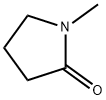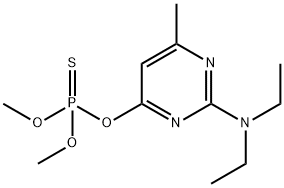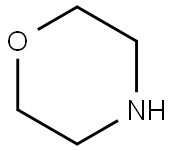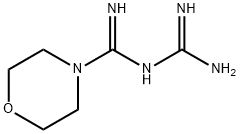4-Methylmorpholine
Synonym(s):N-Methylmorpholine;4-Methylmorpholine;NMM;NMM, N-Methylmorpholine
- CAS NO.:109-02-4
- Empirical Formula: C5H11NO
- Molecular Weight: 101.15
- MDL number: MFCD00006175
- EINECS: 203-640-0
- SAFETY DATA SHEET (SDS)
- Update Date: 2025-09-25 17:15:13

What is 4-Methylmorpholine ?
Chemical properties
colorless and transparent liquid. with characteristic odor. soluble in organic solvents, miscible with water and ethanol.
The Uses of 4-Methylmorpholine
4-Methylmorpholine is an excellent solvent, emulsifier, corrosion inhibitor, Catalyst in polyurethane foamsextraction solvent, stabilizing agent for chlorinated hydrocarbons, and also can be used as pesticide intermediates. 4-Methylmorpholine is widely used in the synthesis of pesticide compounds such as insecticide, fungicide, plant growth regulator, etc. It is also used in the synthesis of fine chemicals such as surfactant, lubricant coolant, metal antirust agent, fiber treatment agent, etc.
The Uses of 4-Methylmorpholine
4-Methylmorpholine is used as a solvent for dyes, resins, waxes and pharmaceuticals. It acts as a crosslinker in the preparation of polyurethane foams, elastomers and adhesives. It is used as a precursor to prepare N-methylmorpholine N-oxide and morpholinium cation based ionic liquids. It is utilized as corrosion inhibitors and anti-scaling agents in industries.
What are the applications of Application
N-Methylmorpholine is a morpholine-containing compound used for protein sequencing analysis
Preparation
4-Methylmorpholine preparation method is to slowly add formaldehyde in morpholine drop by drop, under stirring add formic acid reaction, automatic reflux, and release carbon dioxide. After adding formic acid, heating reflux 4 ~ 5h, cooling and adding sodium hydroxide immediately distillation, collect all the fraction before the boiling point of 99 ℃, and then add sodium hydroxide in the fraction to saturation, cooling the oil layer, drying, fractional distillation, to obtain N-methylmorpholine.
Synthesis Reference(s)
Tetrahedron Letters, 36, p. 4881, 1995 DOI: 10.1016/0040-4039(95)00875-D
General Description
A water-white liquid with an ammonia-like odor. Less dense than water and insoluble in water. Flash point 75°F. May be moderately toxic by ingestion, inhalation and skin absorption. Very irritating to skin, eyes, and mucous membranes. Used as a solvent and to make pharmaceuticals.
Air & Water Reactions
Highly flammable. Insoluble in water.
Reactivity Profile
Amines are chemical bases. They neutralize acids to form salts plus water. These acid-base reactions are exothermic. The amount of heat that is evolved per mole of amine in a neutralization is largely independent of the strength of the amine as a base. Amines may be incompatible with isocyanates, halogenated organics, peroxides, phenols (acidic), epoxides, anhydrides, and acid halides. Flammable gaseous hydrogen is generated by amines in combination with strong reducing agents, such as hydrides.
Hazard
Flammable, dangerous fire risk. Skin irri-tant.
Health Hazard
May cause toxic effects if inhaled or ingested/swallowed. Contact with substance may cause severe burns to skin and eyes. Fire will produce irritating, corrosive and/or toxic gases. Vapors may cause dizziness or suffocation. Runoff from fire control or dilution water may cause pollution.
Fire Hazard
Flammable/combustible material. May be ignited by heat, sparks or flames. Vapors may form explosive mixtures with air. Vapors may travel to source of ignition and flash back. Most vapors are heavier than air. They will spread along ground and collect in low or confined areas (sewers, basements, tanks). Vapor explosion hazard indoors, outdoors or in sewers. Runoff to sewer may create fire or explosion hazard. Containers may explode when heated. Many liquids are lighter than water.
Flammability and Explosibility
Flammable
Safety Profile
Moderately toxic by ingestion and skin contact. Mildly toxic by inhalation. An irritant to skin, eyes, and mucous membranes. Flammable when exposed to heat or flame, can react vigorously with oxidizing materials. When heated to decomposition it emits toxic fumes of NOx.
Purification Methods
Dry it by refluxing with BaO or sodium, then fractionally distil it through a helices-packed column. The picrate has m 227o, the thiocyanate salt has m 103o (from butanone). [Hall J Phys Chem 60 63 1956, Beilstein 27 I 203, 27 III/IV 22.]
Properties of 4-Methylmorpholine
| Melting point: | −66 °C(lit.) |
| Boiling point: | 115-116 °C750 mm Hg(lit.) |
| Density | 0.92 g/mL at 25 °C(lit.) |
| vapor density | >1 (vs air) |
| vapor pressure | 18 mm Hg ( 20 °C) |
| refractive index | n |
| Flash point: | 75 °F |
| storage temp. | Store below +30°C. |
| solubility | Chloroform (Soluble), Ethyl Acetate, Methanol (Slightly) |
| pka | 7.38(at 25℃) |
| form | Liquid |
| appearance | Liquid |
| color | Clear |
| Specific Gravity | 0.920 (20/4℃) |
| PH | 10.6 (50g/l, H2O, 20℃) |
| explosive limit | 2.1%(V) |
| Water Solubility | >500 g/L (20 ºC) |
| Merck | 14,6277 |
| BRN | 102719 |
| Stability: | Volatile |
| CAS DataBase Reference | 109-02-4(CAS DataBase Reference) |
| NIST Chemistry Reference | Morpholine, 4-methyl-(109-02-4) |
| EPA Substance Registry System | 4-Methylmorpholine (109-02-4) |
Safety information for 4-Methylmorpholine
| Signal word | Danger |
| Pictogram(s) |
 Flame Flammables GHS02  Corrosion Corrosives GHS05  Exclamation Mark Irritant GHS07 |
| GHS Hazard Statements |
H225:Flammable liquids H302:Acute toxicity,oral H314:Skin corrosion/irritation |
| Precautionary Statement Codes |
P210:Keep away from heat/sparks/open flames/hot surfaces. — No smoking. P280:Wear protective gloves/protective clothing/eye protection/face protection. P303+P361+P353:IF ON SKIN (or hair): Remove/Take off Immediately all contaminated clothing. Rinse SKIN with water/shower. |
Computed Descriptors for 4-Methylmorpholine
| InChIKey | SJRJJKPEHAURKC-UHFFFAOYSA-N |
4-Methylmorpholine manufacturer
JSK Chemicals
Shilpa Chemspec International Private Limited
New Products
4,4-Difluoropiperidine hydrochloride tert-butyl 9-methoxy-3-azaspiro[5.5]undecane-3-carboxylate Indole Methyl Resin N-Isopropylurea N,N-Dicyclohexylcarbodiimide(DCC) MELDRUMS ACID 5-METHYLISOXAZOLE-4-CARBOXYLIC ACID Magnessium Bis glycinate Zinc ascorbate 1-bromo-2-butyne 2-acetamidophenol 9(10H)-anthracenone Erythrosin B, 4-Piperidinopiperidine 2-((4-morpholinophenylamino) (methylthio) methylene) malononitrile 2,4-dihydroxybenzaldehyde 3-(4-morpholinophenylamino)-5-amino-1H-pyrazole-4-carbonitrile Methyl 2-methylquinoline-6-carboxylate 2,6-dichloro-4-nitropyridine 4-Bromo-2-chlorobenzonitrile 2-(benzylamino)acetic acid hydrochloride 4-(tert-Butoxycarbonylamino)but- 2-ynoic acid 3,4-dihydro-2H-benzo[b][1,4]dioxepine 1-Phenyl-1-cycloprppanecarboxylicacidRelated products of tetrahydrofuran








You may like
-
 N Methyl Morpholine 99%View Details
N Methyl Morpholine 99%View Details -
 N-Methylmorpholine, 99% CAS 109-02-4View Details
N-Methylmorpholine, 99% CAS 109-02-4View Details
109-02-4 -
 4-Methyl Morpholine pure CAS 109-02-4View Details
4-Methyl Morpholine pure CAS 109-02-4View Details
109-02-4 -
 N- Methyl Morpholine CASView Details
N- Methyl Morpholine CASView Details -
 Liquid N- Methyl MorpholineView Details
Liquid N- Methyl MorpholineView Details
109-02-4 -
 N Methyl Morpholine, For Thiox precursorView Details
N Methyl Morpholine, For Thiox precursorView Details
109-02-4 -
 N METHYL MORPHOLINE, Industrial GradeView Details
N METHYL MORPHOLINE, Industrial GradeView Details
109-02-4 -
 4-MethylmorpholineView Details
4-MethylmorpholineView Details
109-02-4
